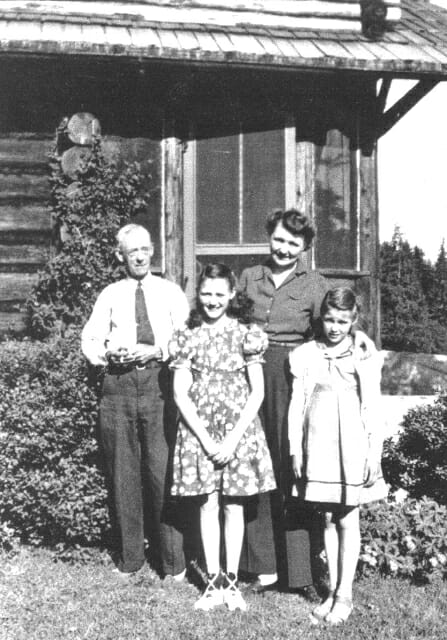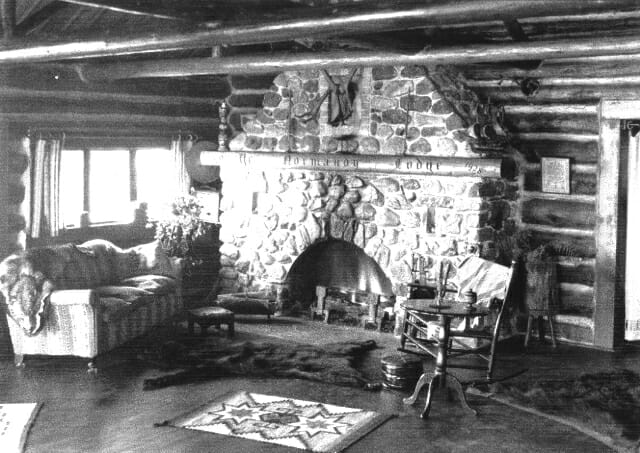Gastineau Channel Memories
Cook, Norman & Amanda
Dee Dee Cook Smith
Norman Cook, from Spokane, Washington, came to Alaska searching for gold. He staked a claim near Cook Inlet and was there when Mt. Katmai erupted in 1912. (He reported that the ash was knee deep.) Norman returned with his father some years later and settled in Juneau where his sister Mary Cook Sutton lived. He became Deputy Clerk of the U.S. District Court and traveled around the territory. Amanda Paulson, from Corvallis, Oregon, arrived in Ketchikan to teach. She met Norman on a short trip to Juneau and he started courting her whenever he was in Ketchikan. They were married at Norman?s log home on Pt. Louisa in July, 1927. They lived in the log home that was built by Norman and his father until it was destroyed by fire in 1948.
On the fireplace handhewn log mantle, Norman had carved in old English letters ?Ye Normandy Lodge? (a combination of their names) and on each end he carved ?July 18? and ?1927? so ?I wouldn?t forget our wedding date.?
While in Ketchikan, Amanda had roomed with fellow teachers, Mac, Ruth and Helen. Subsequently, they met their husbands, Carl Weidman, George Folta and Tony Karnes, and all moved to Juneau. The four ex-teachers and their families became like close relatives all the years to come.
?The Cook Girls,? as they were known were both born at St. Ann?s Hospital, Paula Kay in 1933, and Norma Dee in 1935. When the girls started school, the Cook?s moved into town and rented apartments during the winter. Norman became the accountant for the Territorial Department of Education a few years later. Shortly after Amanda started teaching again (she said she was drafted during WWII), they purchased a home at 511 Kennedy Street on Starr Hill which they lived in until Norman?s death in 1954. Even after the log home was destroyed by fire, they would stay out at the small beach shack on the property. The property was sold before her retirement in 1966. Amanda was considered an excellent teacher, mainly in the business area and helped many students with their careers. She always felt that EVERY child had a potential and guided them to see what that potential was. Amanda retired to Woodburn, Oregon, where she remarried a childhood friend. She passed away among many of her relatives in 1988.
Norman and Amanda were very active in the Juneau area organizations and social life. Norman was a member of the Elk?s Club, Masonic Lodge, Pioneers of Alaska and the Group Health Organization. Amanda belonged to Eastern Star, Pioneers of Alaska, Delta Kappa Gamma, and she was an active school sponsor and counselor for many of the J-Hi activities.
Paula and Dee Dee grew up in Juneau. Paula left to attend Oregon State and Dee Dee to attend the University of Washington. Both returned home during Christmas and summers to work. Parents were always nervous about their children flying home for the holidays. Norman had a heart attack December 12, 1954, but held on until he was assured that both girls were home safely...10 minutes later, he passed on. (Amanda was in the hospital with a broken leg.) Dee Dee stayed out that winter quarter to help Amanda. Paula met and married Burke Critchfield in Juneau in1955, and they lived there for a while. Their daughter, Pam, was born in Juneau. They now reside in California. Dee Dee married, divorced and then married Bob Smith in Seattle and now resides in Washington.
Now for the memories. Paula and I consider ourselves among the most privileged of children because of the opportunities we had while growing up. Here are a few of the reasons why we loved our childhood.
Living in a log home on Pt. Louisa beach: Dad built many things for us while we were growing up. A row boat and four foot replicas, which were given to us, our cousin Anne Henning and Carl Weidman. While still young, a line was tied to the rowboat so we could only go so far either way up or down the beach. When we were older, we would tie up to Welmann Holbrook?s buoy, fish, eat lunch and read the latest magazines. Any crab caught on the line was knocked off before it could scramble around in the boat. If a halibut was too large to bring in, we would simply row ashore and pull it onto the beach.
Dad built us a playground with all kinds of swings, teeter totters, slides, and rings. We would invite the children from Minnie Field?s orphanage three miles down the road to come over and play weekly.
The home was the site for many weddings, picnics and Fourth of July celebrations for the soldiers from Duck Creek during WWII. Mother and Dad opened their home to many people, both friends and dignitaries who wanted to enjoy the workmanship. The living room was 24 x 28 feet, pinewood floors with bear rugs scattered about. The dining table benches were halves of handhewn logs. The table was always decorated with Amanda?s flowers. The huge moose head mounted above the fireplace, the wolverine throw, and the bear rugs were all given to us by ?Uncle? George Folta.
As Paula and Dee Dee grew up, there were many slumber parties, boating adventures, birthday celebrations and campfires on the beach at Pt. Louisa. Lynn Bodding?s father would load his flatbed truck with many of Paula?s friends and they would come out for a party and where they also learned to dance.
Our beautiful log home burned down on July 6, 1948, and was never rebuilt as Norman was failing in health. It was so solidly built that after the fire the fireplace chimney and the basement were still in good shape. The memories of Pt. Louisa will always be a part of our lives.
During WWII, we were very aware of the danger. Paula and I were ?building an igloo? in the grade school yard when our parents came down to get us. From then on things changed. We had to use blackout shades, some of our dear friends were being sent to internment camps, there were a lot of soldiers at Duck Creek Camp and tension was high. On our way back on a ship from Oregon, we had sailors on board manning guns. When we left Ketchikan, the sailors were gone and we were told the war was over.
Girl Scout Camp was a summer treat. We hiked over the trail into Eagle River watching out for bear. Swimming was especially fun because the beach was so sandy and we don?t remember that the water was cold. Swimming in Juneau was a challenge. The Evergreen Bowl pool was pretty cold. Paula and I swam at the beach but when we were in high school everyone discovered ?the dredge? right alongside the airport runway. Then we found ?the dredge? at the glacier which was warmer, but it had leeches which we didn?t like. Lots of parties took place at the glacier dredge.
The Teen Age Club and Zach Gordon were an integral part of teen life in Juneau in the 40?s and 50?s. The club was a special place for all of us when we finally reached the ?legal age? of 13. We would play pool, eat burgers, dance and just enjoy the casual atmosphere. I think Zach Gordon made a big difference in a lot of lives over the years. The club was always a place to go where you felt welcome, but Zach did have rules that you had to follow so it was safe and comfortable.
A lot of us were involved with Rainbow Girls. There were meetings, dances and money raising events, and times to wear long formals and become young ladies. Our church teen groups and Rainbow gave us experiences that enriched us and taught us responsibility.
Both Paula and I worked during vacations. We had many jobs from babysitting to working in offices. My highlight was working for ANAC (Alaska Native Arts and Crafts Clearing House) during my last two years before college. I had to receive, sort, record and price the beautiful ivory and artwork that came in from all over Alaska. We stamped it with an ANAC stamp to assure genuine Alaska crafts. One windy and cold winter day, a carver rowed over from Douglas to bring us his beautiful totem pole which was about 5 feet tall. I was so impressed that he would risk his life to get the pole to us on such a day.
Peter Ludwig was a very important member of the Cook ?family.? One stormy night at Pt. Louisa, Mother was alone with us girls and Peter came to the door asking for help. In those days, Alaska homes were always open to anyone. After that, Peter was part of our lives. He was a fisherman, trapper and most important, a true and dear friend. Peter was of German origin via Canada. Dad helped him stay out of the internment camp during the war. When you saw him on the street, he looked rather scruffy and rough, but when he came to our house he was always clean and neat. Peter was always leaving us something...otter furs for a coat, fish, crab and when I visited in 1965, he came by and left a large salmon for my five year old son. That was Peter. In 1954, Peter came and cared for Dad when he was sick and he stayed with him until he passed on. Peter knew he was always welcome so he would show up at anytime and was included in every holiday. I think he made our lives so much richer by just knowing him.
It was wonderful growing up in a small town. Everyone knew you. I would sit in the dentist?s waiting room along with Toni Green, a local prostitute, and we would talk. Every winter Gold Street was closed off for sledders. We hiked in the snow over to Douglas for the big D-Hi-J-Hi games. Also as teens we loved meeting at Percy?s for fries and gravy, or hiking and using climbers or taking the snowcat to the ski area during the winter. What a life!
As we look back, we couldn?t possibly have grown up in a better time or town. We have our memories and have passed many of these experiences on to our children. How lucky can you be?
 |
Norman, Amanda, Paul Kay and Norma Dee, Normandy Lodge, Pt. Louisa, 1944. |
 |
\"Ye Normandy Lodge\" 1930. |
